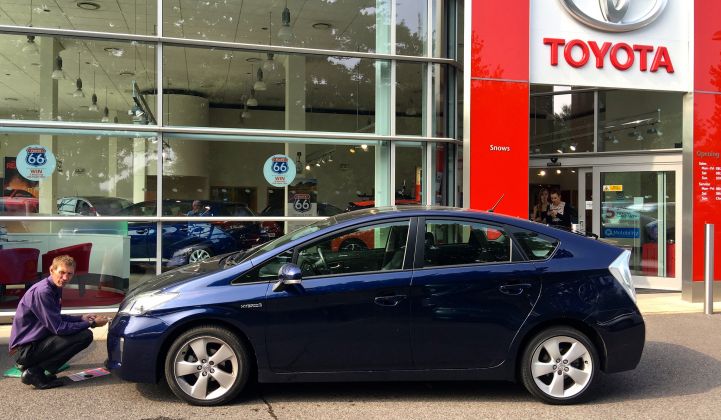Hybrid cars might be better than battery electric vehicles for decarbonizing the transport system, according to a European researcher.
In an analysis published on The Energy Collective, a clean energy blog, Schalk Cloete claims BEVs offer no clear fuel-cost savings and “insignificant” carbon dioxide and tailpipe emission benefits compared to what he termed “efficient internal combustion engines.”
Although Cloete acknowledges up front that BEVs will "see impressive growth over coming years," he argues in two follow-up articles that future developments in hybrid drivetrains and clean fuels will keep the internal combustion engine highly competitive as BEV costs decline. The findings contrast with the prevailing view among low-carbon advocates that electrification of transport is a critical step in reducing greenhouse gas emissions.
Comparing the hybrid and BEV versions of a Hyundai Ioniq, Cloete, a scientist attached to Norway’s Foundation for Scientific and Industrial Research (abbreviated to SINTEF in Norwegian), found only a small cost benefit in going fully electric (this research is independent from his SINTEF duties).*
The BEV version was $5,000 more expensive, though, he said. Assuming that fuel would amount to around 10 percent of total ownership costs for both models, a 10 percent fuel-cost advantage for the BEV would represent a “negligible” 1 percent difference overall.
On emissions, Cloete noted that BEV benefits would depend on the generation mix of the grid supply. At the outset, BEVs start off with a handicap of 100 kilos of embodied carbon dioxide per kilowatt-hour of storage capacity from battery manufacturing, he said.
And based on an average global electricity carbon intensity of 0.42 kilos per kilowatt-hour in 2040, predicted in the International Energy Agency’s latest New Policies Scenario, Cloete said BEVs would not offer “any fundamental advantage” compared to efficient ICEs.
After 2040, he said, the carbon intensity of grid electricity would likely decrease, but so would that of ICE fuels, thanks to greater use of biofuels and synfuels in transport.
The analysis appears to offer a compelling case for questioning current moves toward vehicle electrification, and the subsidies and policies that facilitate that move, but it rests on several uncertain assumptions. The first is that what Cloete calls ICEs are in fact hybrids with an assumed drivetrain efficiency of 50 percent.
That is higher than anything currently on the road. The Prius, for example, has a thermal efficiency of 40 percent. Conventional ICEs tend to be around 25 percent.
While hybrids are an established vehicle class, they have failed to capture the popular imagination in the same way as, for example, Tesla’s all-electric sports cars. Partly this is because of dodgy handling.
Writing about Toyota’s new Plug-In Mark II hybrid this year, one reviewer said: “It drives like a wet Sunday afternoon in January,” adding, “Frankly, if the Prius plug-in is the future of motoring, I’ll wait for the jet pack.”
Cloete told GTM he assumed that such glitches would be ironed out over time. “My view is that a hybrid will become better to drive than a conventional ICE car and that the cost premium will disappear,” he said.
However, getting to an average 50 percent ICE efficiency would also require other speculative advances, such as the emergence of specialized highway vehicles including driverless taxis.
“To be honest, I’d be bitterly disappointed in human ingenuity and common sense if we arrive at 2050 and single-person-in-car is still the dominant mode of personal mobility,” Cloete said.
“But yes, I concede that 50 percent ICE efficiency, on average, is not going to happen if most driving takes place in stop-start city traffic created by single-person-in-car travel," he added. "I sincerely hope human ingenuity is up to the task of eliminating this massive inefficiency from society.”
A further assumption in the cost analysis is that increasing penetration of intermittent renewables on the grid will increase electricity prices. Cloete said he used an International Energy Agency report from 2014, The Power of Transformation, as the basis for this plank of his analysis.
However, the assumption remains questionable. In Spain, where wind power supplied more than 20 percent of electricity demand in 2015, renewable generation is regularly credited with bringing down day-to-day energy prices.
And elsewhere, moves toward distributed generation systems are leading to new business models (for example, those based on blockchain), which promise to radically cut the cost of electricity.
Overall, said Colin McKerracher, head of advanced transport at Bloomberg New Energy Finance, Cloete’s analysis contains “some reasonable points, but also some fundamental problems. Not least is comparing everything to a Prius.”
Electric vehicles have lower carbon emissions per kilometer today, he said, “and that gap continues to widen in most countries over time, even with very aggressive assumptions on how fast average ICEs improve.”
*Updated to clarify that this research is separate from Cloete's work with SINTEF.



